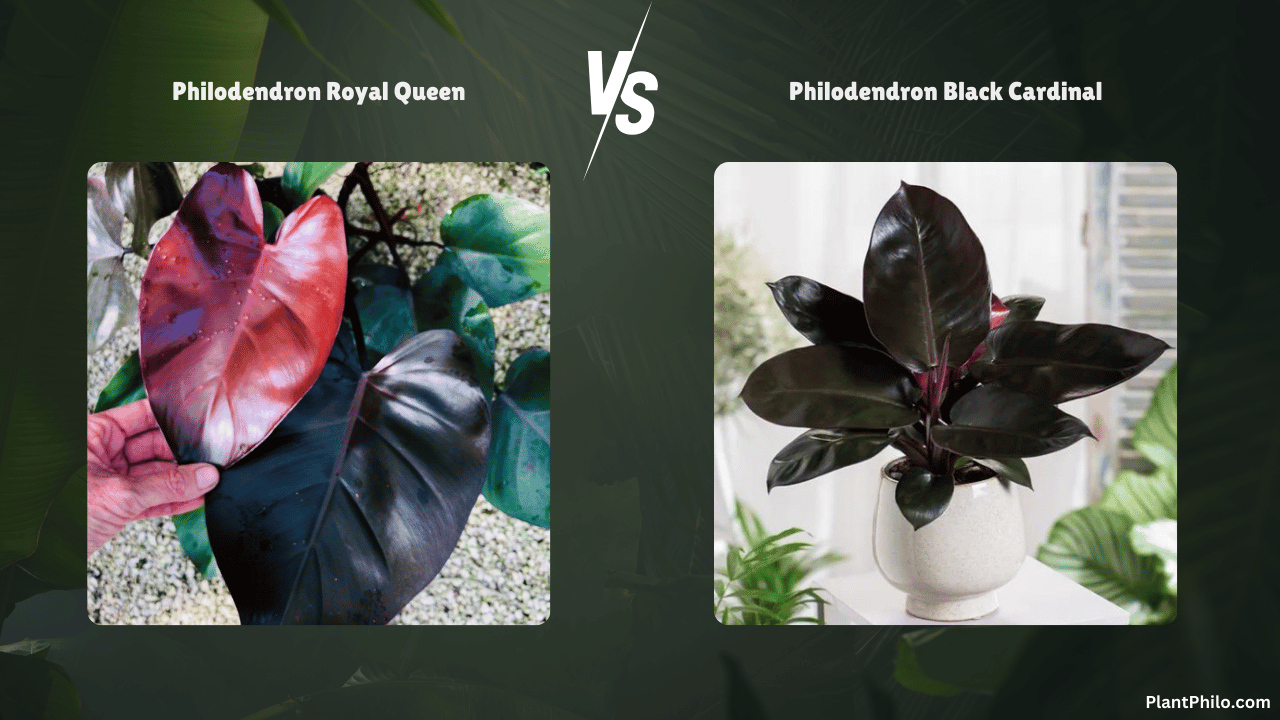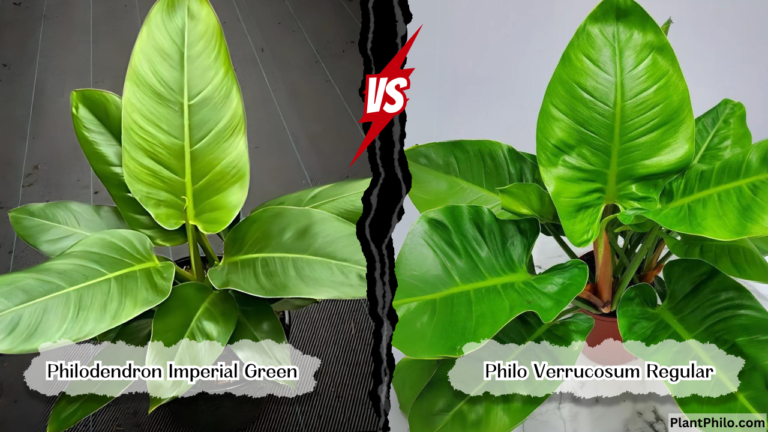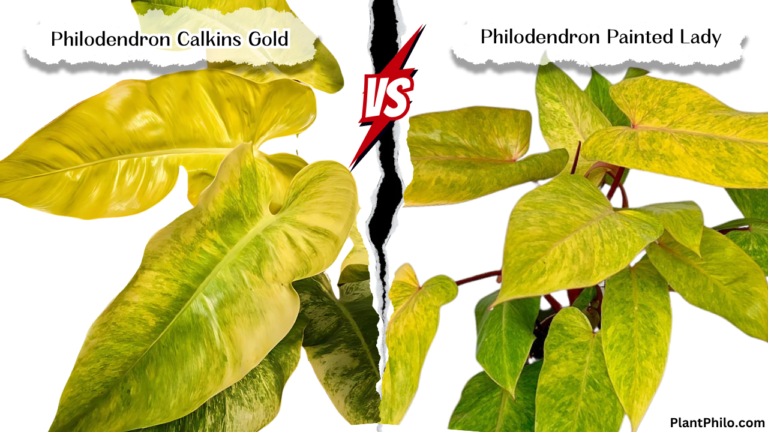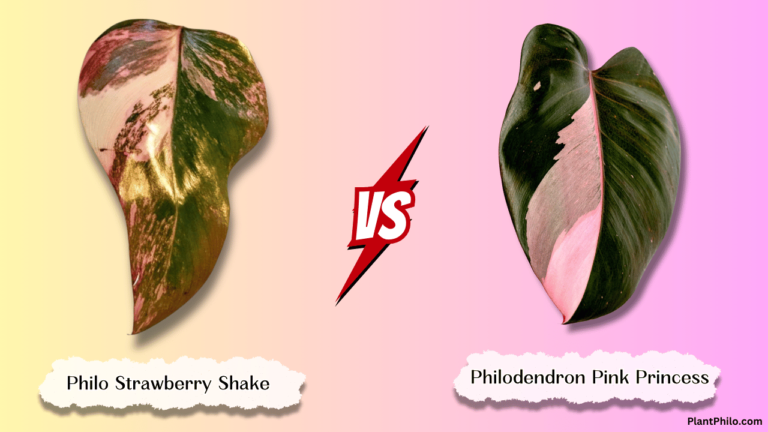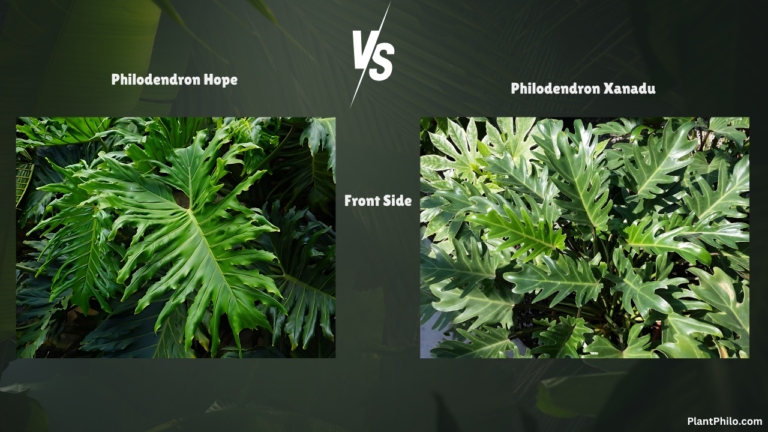Philo Royal Queen vs. Black Cardinal: Differences & Easy Care Tips
Philodendron Royal Queen and Black Cardinal are both loved by plant lovers, yet they have unique traits that set them apart. The Royal Queen shows off bright green leaves highlighted by yellow veins, while the Black Cardinal impresses with its deep, dark purple-black leaves.
Both of these tropical plants come from the Araceae family and thrive under similar care. The Royal Queen grows more quickly and can get larger than the Black Cardinal, with leaves that stretch up to 2 feet in length. The Black Cardinal stays more compact, with leaves about 1 foot long.
Choosing between these Philodendrons often depends on your taste and available space. The Royal Queen brings a bold look with its larger size and bright colors. Meanwhile, the Black Cardinal provides a more refined, elegant style with its dark tones. Both can add a fresh, tropical vibe to any room.
Key Takeaways
- Royal Queen has green leaves with yellow veins, while Black Cardinal has dark purple-black foliage
- Both plants thrive in similar conditions but Royal Queen grows larger and faster
- Choose based on your space and color preferences – Royal Queen for bold impact, Black Cardinal for subtle elegance
Comparison Table: Philodendron Royal Queen vs Black Cardinal
| Feature | Philodendron Royal Queen | Philodendron Black Cardinal |
| Botanical Name | Philodendron erubescens ‘Royal Queen’ | Philodendron erubescens ‘Black Cardinal’ |
| Common Names | Royal Queen Philodendron | Black Cardinal Philodendron |
| Origin | Cultivar | Cultivar |
| Growth Habit | Self-heading, can become vining with maturity | Vining, climbing with support |
| Leaf Shape & Size | Large, ovate to cordate (heart-shaped), up to 12-16 inches long | Elongated, lance-shaped to ovate, up to 12-18 inches long |
| Color | Deep green with a subtle burgundy sheen, new leaves often reddish | Deep burgundy to almost black, new growth can be brighter red |
| Light Requirements | Bright, indirect light to maintain deep color; tolerates low light but may lose vibrancy | Bright, indirect light; tolerates low light but color may fade |
| Watering Needs | Water when top 2-3 inches of soil are dry | Water when top 2-3 inches of soil are dry |
| Humidity | Appreciates higher humidity but tolerates average levels | Appreciates higher humidity but tolerates average levels |
| Fertilizing | Balanced liquid fertilizer diluted to half-strength, monthly during growing season | Balanced liquid fertilizer diluted to half-strength, monthly during growing season |
| Common Pests & Diseases | Mealybugs, scale, spider mites, root rot (if overwatered) | Mealybugs, scale, spider mites, root rot (if overwatered) |
| Propagation | Stem cuttings in water or soil | Stem cuttings in water or soil |
| Toxicity | Toxic to pets and humans if ingested | Toxic to pets and humans if ingested |
| Petiole | Long, sturdy, reddish | Long, sturdy, reddish-purple |
| Stem | Thick, upright, may become vining with age | Thinner, vining, can develop aerial roots |
| New Leaf Color | Reddish, maturing to deep green with a burgundy sheen | Bright red, maturing to deep burgundy or almost black |
| Air Purifying | Moderate air purifying qualities | Moderate air purifying qualities |
| Overall Difficulty | Easy to care for | Moderately easy to care for |
| Mature Size | Can reach 3-4 feet tall and wide, may vine with maturity | Can reach 6-8 feet with support |
Overview of Philodendron Varieties
Philodendron plants come in many shapes and sizes. Two popular varieties are Royal Queen and Black Cardinal. These plants have unique features that make them stand out in indoor gardens.
Characteristics of Philodendron Royal Queen
Philodendron Royal Queen is known for its stunning foliage. It has large, heart-shaped leaves that can grow up to 12 inches long. The leaves are deep green with a velvety texture.
This plant is a climber. It can reach heights of 6 feet or more when given proper support. Royal Queen grows best in bright, indirect light.
The stems of Royal Queen are thick and sturdy. They have a reddish-purple color that adds visual interest. This plant is favored by interiorscapers for its attractive appearance and easy care.
Royal Queen likes humid conditions. You can mist its leaves or use a pebble tray to increase moisture. It’s not too picky about soil, but good drainage is important.
Characteristics of Philodendron Black Cardinal
Black Cardinal is a hybrid Philodendron with striking dark foliage. Its leaves are large and glossy, with a deep burgundy to almost black color. The leaves can grow up to 10 inches long.
This plant has a bushy, compact growth habit. It typically reaches heights of 2-3 feet. Black Cardinal prefers medium to bright indirect light.
The stems of Black Cardinal are dark and sturdy. New leaves often emerge with a bronze tint before darkening. This plant is part of a series of crosses involving P. wendlandii and other species.
Black Cardinal is known for its tolerance to lower light conditions. It’s a great choice for offices or rooms with less natural light. Like Royal Queen, it enjoys humidity but can adapt to average home conditions.
Comparative Analysis
Philodendron Royal Queen and Black Cardinal have distinct characteristics that set them apart. Let’s explore their key differences in leaf shape, growth patterns, and color variations.
Leaf Shape and Texture
The Royal Queen and Black Cardinal philodendrons have unique leaf shapes that make them easy to tell apart. Royal Queen leaves are heart-shaped with deep lobes. They have a glossy texture that feels smooth to the touch. The leaves can grow quite large, often reaching 12-18 inches in length.
Black Cardinal leaves are more oval-shaped with a pointed tip. They have a velvety texture that gives them a soft, fuzzy feel. Black Cardinal leaves tend to be smaller than Royal Queen, typically growing 8-12 inches long.
Both plants have thick, leathery leaves that are resistant to damage. This makes them durable as cut foliage for floral arrangements.
Growth Patterns
Royal Queen is known for its vigorous, climbing growth habit. It can quickly reach heights of 6-8 feet or more when given proper support. The vines tend to grow upward and outward, creating a bushy appearance.
Black Cardinal has a more compact growth pattern. It grows slower than Royal Queen and stays relatively short, usually reaching 2-3 feet tall. This plant has a fuller, more dense shape as it matures.
You’ll find Royal Queen works well as a climber on trellises or moss poles. Black Cardinal is better suited as a tabletop or shelf plant due to its smaller size.
Color Variations
The color differences between these philodendrons are striking. Royal Queen leaves start out as a light green and mature to a deep, emerald green. The stems are often a reddish color, adding visual interest.
Black Cardinal, true to its name, has very dark foliage. New leaves emerge a deep burgundy color. As they mature, they turn an intense, almost black shade of green. This dramatic coloring makes Black Cardinal a popular choice for adding contrast to plant displays.
Both plants may show some color variation based on light exposure. In brighter light, Royal Queen’s leaves may be a lighter green. Black Cardinal leaves might appear more green than black in lower light conditions.
Care Requirements
Philodendron Royal Queen and Black Cardinal have similar care needs, but some key differences exist. Paying attention to these specifics will help your plants thrive.
Light and Temperature Necessities
Both Philodendron varieties prefer bright, indirect light. Place them near a window with filtered sunlight. Too much direct sun can scorch their leaves. Royal Queen can handle slightly more light than Black Cardinal.
Keep temperatures between 65-80°F (18-27°C) for best growth. Royal Queen is a bit more cold-sensitive, so keep it above 60°F (15°C). Black Cardinal can tolerate temps down to 55°F (13°C) for short periods.
In winter, move plants away from cold drafts. Use grow lights if natural light is limited. This helps maintain leaf color and growth, especially for Black Cardinal.
Watering and Humidity Preferences
Water these Philodendrons when the top inch of soil feels dry. Royal Queen needs slightly more frequent watering than Black Cardinal. Allow the soil to dry out a bit more between waterings for Black Cardinal to prevent root rot.
Both plants love humidity. Aim for 60-70% humidity levels. Use a pebble tray or humidifier to increase moisture. Mist leaves a few times a week, focusing on Black Cardinal’s darker foliage.
In dry indoor air, Black Cardinal’s leaves may curl. This is a sign it needs more humidity. Royal Queen is a bit more forgiving in lower humidity.
Soil and Fertilization Needs
Use a well-draining potting mix for both plants. A mix of peat moss, perlite, and orchid bark works well. Royal Queen prefers slightly more organic matter in its soil.
Fertilize during the growing season (spring and summer) with a balanced, water-soluble fertilizer. Use half-strength every 2-3 weeks. Black Cardinal needs less fertilizer than Royal Queen.
Philodendron Black Cardinal is more sensitive to over-fertilization. Cut back on feeding in fall and winter for both plants. Repot every 2-3 years or when roots outgrow the container.
Toxicity & Petiole: Royal Cautions & Crimson Accents
While these plants are visually stunning, they’re not meant for consumption. Both contain calcium oxalate crystals, which can cause irritation and swelling if ingested. So, admire their beauty from a safe distance and keep them out of reach of pets and curious children.
Both plants also share a striking feature: their petioles (leaf stalks) are often a vibrant reddish or reddish-purple, adding a touch of crimson elegance to their overall appearance.
Overall Difficulty: A Regal Welcome
Both the Royal Queen and Black Cardinal are considered relatively easy to care for, making them suitable for plant enthusiasts of various skill levels.
However, the Royal Queen, with its self-heading habit and slightly higher tolerance for lower light, might be a tad easier for beginners. The Black Cardinal, while still manageable, requires a bit more attention to its climbing needs and light requirements.
Propagation Techniques
Philodendron Royal Queen and Black Cardinal can be grown from cuttings. Each variety has some unique needs during propagation.
Propagating Philodendron Royal Queen
To propagate Royal Queen, take stem cuttings with at least one leaf and node. Cut just below a node using clean shears. Remove lower leaves, keeping 1-2 at the top. Place the cutting in water or moist potting mix.
For water propagation, change the water weekly. Roots should appear in 2-3 weeks. Once roots are 2-3 inches long, plant in soil.
For soil propagation, use a well-draining mix. Keep soil moist but not soggy. Place in bright, indirect light. Roots typically form in 3-4 weeks.
Royal Queen can also be propagated through tissue culture in labs. This method produces many identical plants quickly.
Propagating Philodendron Black Cardinal
Black Cardinal propagation is similar to Royal Queen, but with a few key differences. Take stem cuttings with 2-3 leaves and nodes. Use sharp, clean scissors to cut below a node.
Place cuttings in water or damp sphagnum moss. Black Cardinal often roots faster in moss than water. Change water weekly if using that method.
Keep cuttings warm (70-80°F) and in bright, indirect light. Roots usually form in 2-4 weeks. Once roots are 1-2 inches long, plant in a well-draining potting mix.
Black Cardinal is mainly propagated through cuttings, as tissue culture is less common for this variety. Air layering can also work for larger plants.
Common Issues and Solutions
Philodendron Royal Queen and Black Cardinal can face similar challenges. Pests, diseases, and environmental factors may affect their health and growth. Let’s explore these issues and how to address them.
Pest and Disease Management
Philodendrons can attract various pests. Spider mites, mealybugs, and scale insects are common culprits. To manage these pests:
- Inspect plants regularly
- Use neem oil or insecticidal soap
- Wipe leaves with a damp cloth
For severe infestations, you may need stronger treatments.
Diseases can also affect these plants. Root rot is a frequent problem. To prevent it:
- Use well-draining soil
- Avoid overwatering
- Ensure pots have drainage holes
If you spot yellow leaves or mushy stems, act quickly. Remove affected parts and repot in fresh soil if needed.
Environmental Stress Factors
Your Philodendron’s environment plays a big role in its health. Both Royal Queen and Black Cardinal prefer indirect light. Too much direct sun can scorch their leaves.
Temperature is crucial. Keep your plants between 65-80°F (18-27°C). Cold drafts or sudden temperature drops can harm them.
Humidity is another key factor. Aim for 50-60% humidity. In dry homes, you can:
- Use a pebble tray with water
- Group plants together
- Run a humidifier
Overwatering is a common issue. Water when the top inch of soil feels dry. Adjust your watering schedule based on season and growth rate.
Why people get confused between Royal Queen & Black Cardinal
Plant lovers often mix up Royal Queen and Black Cardinal philodendrons. These two types look alike, which leads to confusion.
- Both plants have dark leaves that catch the eye. Royal Queen’s leaves are deep green with a reddish tint. Meanwhile, Black Cardinal’s leaves are even darker, almost black.
- The leaf shape is another tricky part. Both plants have heart-shaped leaves. To the untrained eye, they can seem nearly identical.
- Size is also misleading. Royal Queen and Black Cardinal grow to similar heights. Without seeing them side by side, it’s hard to spot the small differences.
- Their care needs add to the muddle. Both plants like similar growing conditions. They need bright, indirect light and regular watering.
- Even expert gardeners can get stumped. The plants’ subtle differences are hard to spot without careful study.
- Names cause mix-ups too. “Royal” and “Cardinal” both sound regal. This similarity in names makes people think the plants are more alike than they are.
To tell them apart, look closely at leaf color and texture. Royal Queen has a slight sheen, while Black Cardinal is more matte. With practice, you’ll spot the difference.
Fun facts about Royal Queen vs. Black Cardinal
Philodendron Royal Queen and Black Cardinal are both stunning tropical plants, but they have some fun differences. Here are some interesting facts about these two beauties:
• Royal Queen has pink-tinged leaves when young, while Black Cardinal’s new growth is deep red.
• Black Cardinal’s mature leaves are darker, almost black in color. Royal Queen’s leaves stay a lighter green.
• Royal Queen tends to grow faster and larger than Black Cardinal. It can reach up to 3 feet tall indoors.
• Both plants are climbers that can be trained on trellises or poles.
How to identify Royal Queen or Black Cardinal?
Royal Queen is more tolerant of low light conditions than Black Cardinal. However, both prefer bright indirect light for best growth and color.
Black Cardinal’s leaves are thicker and more leathery compared to Royal Queen’s thinner leaves. This makes Black Cardinal more resistant to damage.
Royal Queen produces more leaves more quickly, giving it a fuller appearance. Black Cardinal grows more slowly but develops a striking sculptural form.
Both plants are relatively easy to propagate from stem cuttings. Royal Queen tends to root a bit faster than Black Cardinal.
While toxic if ingested, these philodendrons are considered air-purifying plants that can help clean indoor air.
FAQs: Addressing Your Royal Queries
What’s the main difference between the Royal Queen and Black Cardinal?
The main differences lie in their leaf shape, color intensity, and growth habit. The Royal Queen has broader, heart-shaped leaves with a deep green color and a burgundy sheen, while the Black Cardinal has elongated, triangular leaves with a darker, almost black coloration. The Royal Queen is self-heading, while the Black Cardinal is a climber.
Which plant is bigger between the Royal Queen and Black Cardinal?
The Philodendron Black Cardinal typically grows larger than the Royal Queen, reaching up to 6-8 feet with support.
Can I grow the Royal Queen and Black Cardinal in low light?
They can tolerate low light, but their growth will slow down, and their colors might fade.
How often should I fertilize the Royal Queen and Black Cardinal?
Fertilize monthly during the growing season (spring and summer) with a balanced liquid fertilizer diluted to half-strength.
What’s the best way to increase humidity?
Misting, pebble trays, and humidifiers are all effective ways to increase humidity.
Can I propagate the Royal Queen and Black Cardinal from leaf cuttings?
No, these Philodendrons cannot be propagated from leaf cuttings alone. You’ll need a stem cutting with at least one node.
How do I know if my Royal Queen and Black Cardinal needs repotting?
If the roots are growing out of the drainage holes or the plant is becoming rootbound, it’s time to repot.
Can I grow the Royal Queen and Black Cardinal outdoors?
Yes, in warm climates with indirect light, but protect them from direct sun and extreme temperatures.
Are the Royal Queen and Black Cardinal safe for pets?
No, both plants are toxic to pets and humans if ingested.
Which plant is more expensive among the Royal Queen and Black Cardinal?
Both plants can be quite expensive due to their rarity and popularity, but prices can vary depending on the size and overall health of the plant.

